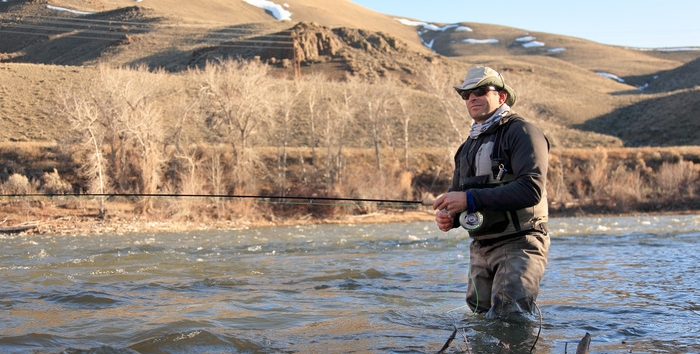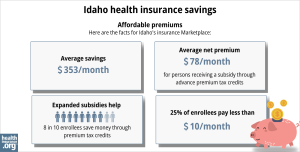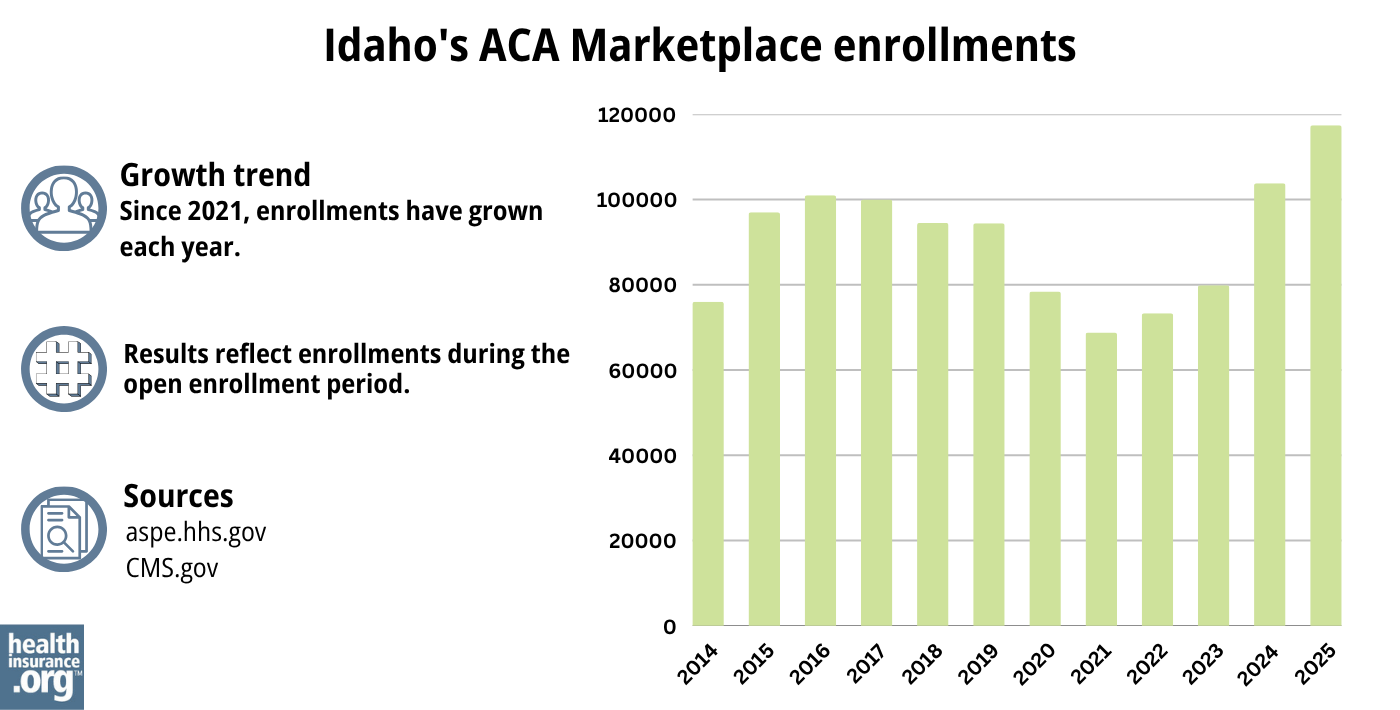Home > Health insurance Marketplace > Idaho
Idaho Marketplace health insurance in 2025

Compare ACA plans and check subsidy savings from a third-party insurance agency.

Idaho health insurance Marketplace guide
This Idaho health insurance guide, including the FAQs below, is designed to help you understand the health coverage options and possible financial assistance available to you and your family in Idaho.
Idaho created its own state-based health insurance exchange (Marketplace), which is called Your Health Idaho. This is Idaho’s platform where residents can shop for individual and family health plans offered by eight private health insurance carriers3 (coverage areas vary from one insurer to another). All eight carriers plan to continue to offer coverage in 2025.4
When you enroll in a plan through Your Health Idaho, you may find that you’re eligible for financial assistance that reduces the monthly cost of your coverage (premium subsidies), and possibly also your out-of-pocket expenses (cost-sharing reductions, or CSR). These are federal subsidy programs created by the Affordable Care Act, and eligibility depends on your income and circumstances.
Your Health Idaho applicants who appear to be eligible for Medicaid will be referred to Idaho Medicaid where they can complete an application for coverage.
Frequently asked questions about health insurance in Idaho
Who can buy Marketplace health insurance in Idaho?
In order to sign up for private health coverage through Your Health Idaho, you must:5
- Be an Idaho resident and lawfully present in the United States
- Not be incarcerated
- Not be enrolled in Medicare6
So most Idaho residents are eligible to enroll in coverage through the exchange. But eligibility for financial assistance is a bigger question for most people, and there are a few additional eligibility rules to qualify for subsidies through Your Health Idaho.
To qualify for income-based Advance Premium Tax Credits (APTC) or cost-sharing reductions (CSR), you must:
- Not be eligible to enroll in an affordable employer-sponsored health plan. If you have access to an employer’s health plan and aren’t sure if it’s considered affordable, you can use our Employer Health Plan Affordability Calculator to see if you might qualify for premium subsidies to offset the cost of a Your Health Idaho plan.
- Not be eligible for Idaho Medicaid or CHIP.
- Not be eligible for premium-free Medicare Part A.7
- If married, file a joint tax return.8
- Not be able to be claimed by someone else as a tax dependent.8
Beyond those basic parameters, qualifying for Your Health Idaho’s subsidies will depend on your household’s income. Here’s how that’s calculated under the ACA.
When can I enroll in an ACA-compliant plan in Idaho?
Your Health Idaho’s open enrollment period is shorter than any other state’s enrollment window, and both its start and end dates are unique.
For 2025 coverage, Your Health Idaho has said that open enrollment runs from October 15, 2024 to December 16, 2024.4
This is very similar to the open enrollment dates that Idaho has historically used, with the enrollment window beginning on October 15 and ended on December 15.9 So enrollment has typically started about two weeks earlier than it does in other states, but ended a month earlier. In recent years, Idaho has been the only state where open enrollment ended in December.
It’s noteworthy that CMS finalized a rule change in 2024 designed to ensure standardization of open enrollment in state-based exchanges. But there was a partial exception for Idaho in the final rule. It clarified that a state-based exchange that began its most recent open enrollment before November 1, 2023, and ended it before January 15, 2024 could continue to begin open enrollment before November 1 and end it before January 15 — but only if the open enrollment period lasts for at least 11 weeks. That rule is clarified in 45 CFR § 155.410(e)(4)(iii).
But Your Health Idaho is still planning to run an open enrollment period that lasts just under nine weeks. It’s unclear how this is in compliance with the federal rules that were finalized in 2024.
After open enrollment ends, you may still be eligible to enroll or make a plan change, but only if you qualify for a special enrollment period.
Most special enrollment periods are triggered by qualifying life events, such as giving birth or losing other health coverage. However, some people can qualify for a special enrollment period without a specific qualifying life event.10
Enrollment in Idaho Medicaid and CHIP is available year-round for eligible residents.
How do I enroll in an Idaho Marketplace plan?
To enroll in an ACA Marketplace/exchange plan in Idaho, you can:
- Visit Your Health Idaho, which is Idaho’s health insurance exchange (Marketplace). The Your Health Idaho website will allow you to compare available health plans, determine whether you’re eligible for financial assistance, and enroll in a health plan.
- Enroll in a Your Health Idaho plan with the help of an insurance broker or certified enrollment counselor.
You can reach Your Health Idaho’s call center at 855-944-3246.
How can I find affordable health insurance in Idaho?
Income-based subsidies (APTC, created by the Affordable Care Act) are available to lower the amount you pay for your health coverage each month. These subsidies are available to enrollees who meet the eligibility requirements and select a metal-level health plan through Your Health Idaho.
Eighty-seven percent of the people with effectuated coverage through Your Health Idaho in early 2024 were receiving for premium subsidies. These subsidies paid an average of $392/month, reducing the average enrollee’s premium (including those who pay full price) to about $118/month.11
Although most Your Health Idaho enrollees qualify for premium subsidies, the state’s reinsurance program helps to keep full-price premiums lower than they would otherwise be, making coverage more affordable for people who have to pay full price.12
If your household doesn’t earn more than 250% of the federal poverty level, you’ll also be eligible for federal cost-sharing reductions (CSR) as long as you select a Silver-level plan through Your Health Idaho. These subsidies will reduce your deductible and other out-of-pocket expenses, making health care more affordable. One-third of Your Health Idaho enrollees were receiving CSR benefits as of early 2024.11
If you’re eligible for APTC and CSR, you can use them both if you enroll in a Silver-level plan through Your Health Idaho (APTC can be used with any metal-level plan, but you can only get CSR benefits if you enroll in a Silver plan).

Source: CMS.gov 13
Depending on your income and circumstances, you may be able to enroll in free or low-cost health coverage through Idaho Medicaid or CHIP. Learn more about whether you might be eligible for these programs in Idaho.
Idaho also has some unique “enhanced” short-term health plans available, which follow various state rules and provide more substantial coverage than traditional short-term health plans.14 These can potentially be a good option for a person who isn’t eligible for Marketplace subsidies, depending on the circumstances (subsidies cannot be used with any type of short-term plan).
But starting with plans that take effect in September 2024, new federal rules will strictly limit the allowable duration of short-term health insurance.
How many insurers offer Marketplace coverage in Idaho?
For 2024 coverage, eight insurers offer exchange plans in Idaho, with varying coverage areas.15 All eight will continue to offer coverage in 2025.4
The same eight insurers offered coverage for 2023, but there have been some additions in recent years: Molina joined the Idaho marketplace in 2022. And for 2023, St. Luke’s Health Plan and Moda Health joined.16 17
Are Marketplace health insurance premiums increasing in Idaho?
For 2025, the following average rate changes have been approved for Idaho’s Marketplace insurers, amounting to an overall average rate increase of 5%, before any subsidies are applied.4
Idaho’s ACA Marketplace Plan 2025 PROPOSED Rate Changes by Insurance Company |
|
|---|---|
| Issuer | Percent Increase |
| Blue Cross of Idaho Health Service, Inc. | -3% |
| Molina Healthcare of Utah | 2% |
| Mountain Health CO-OP (an ACA-created CO-OP): | -1% |
| PacificSource Health Plans | 6% |
| Regence Blue Shield of Idaho | 11% |
| SelectHealth | 8% |
| St. Luke’s Health Plan | 3% |
| Moda Health | 7% |
Source: Idaho Department of Insurance18
Average rate changes apply to full-price rates, and most enrollees do not pay full price: Eighty-seven percent of Your Health Idaho enrollees qualified for advance premium subsidies in 2024, offsetting some or all of their monthly premium cost.11
Subsidy amounts vary from one enrollee to another and change annually depending on the cost of the second-lowest-cost Silver plan relative to the enrollee’s household income. The American Rescue Plan and the Inflation Reduction Act have resulted in larger, more widely available subsidies through 2025.
Here’s an overview of how average pre-subsidy premiums have changed over the years in Idaho’s individual/family market:
- 2016: Average increase of 20%19
- 2017: Average increase of 24%20
- 2018: Average increase of 27%21
- 2019: Average increase of 5%22
- 2020: Average increase of 6.3%23
- 2021: Average increase of 1%24
- 2022: Average decrease of 2%25
- 2023: Average decrease of 3.6%26 (reinsurance program took effect)
- 2024: Average decrease of 1%27
How many people are insured through Idaho’s Marketplace?
What health insurance resources are available to Idaho residents?
Your Health Idaho – This is the state-based exchange/Marketplace in Idaho, where you can compare plans, determine financial assistance eligibility, and select a health plan. You can reach Your Health Idaho at 855-YHIdaho (855-944-3246)
State Exchange Profile: Idaho – The Henry J. Kaiser Family Foundation overview of Idaho’s progress toward creating a state health insurance exchange.
Idaho Department of Insurance – Regulates the insurance industry in Idaho, and addresses consumers’ questions and complaints related to insurance.
(208) 334-4250 / toll-free (800) 721-3272.
Idaho Senior Health Insurance Benefits Advisors – A service for Idaho Medicare beneficiaries and their caregivers, providing information and assistance with questions related to Medicare eligibility, enrollment, and claims.
Louise Norris is an individual health insurance broker who has been writing about health insurance and health reform since 2006. She has written dozens of opinions and educational pieces about the Affordable Care Act for healthinsurance.org.

Looking for more information about other options in your state?
Need help navigating health insurance options in Idaho?
Explore more resources for options in Idaho including short-term health insurance, dental insurance, Medicaid and Medicare.
Speak to a sales agent at a licensed insurance agency.
Footnotes
- ”2025 OEP State-Level Public Use File (ZIP)” Centers for Medicare & Medicaid Services, Accessed May 13, 2025 ⤶ ⤶
- ”Health insurance rates for 2025 now available to the public” Idaho Department of Insurance. Oct. 1, 2024 ⤶
- Idaho Rate Review Individual, Summary for 2024 Coverage. Idaho Department of Insurance. Accessed December 2023. ⤶
- ”Health insurance rates for 2025 now available to the public” Idaho Department of Insurance. Oct. 1, 2024 ⤶ ⤶ ⤶ ⤶
- Frequently Asked Questions About Your Health Idaho. Your Health Idaho. Accessed December 2023. ⤶
- Medicare and the Marketplace, Master FAQ. Centers for Medicare and Medicaid Services. Accessed November 2023. ⤶
- Medicare and the Marketplace, Master FAQ. Centers for Medicare and Medicaid Services. Accessed November 2023. ⤶
- Premium Tax Credit — The Basics. Internal Revenue Service. Accessed May 10, 2024 ⤶ ⤶
- “Your Health Idaho Policy Manual” yourhealthidaho.org, June 21, 2023 ⤶
- “Who doesn’t need a special enrollment period?“ healthinsurance.org, Accessed August 2023 ⤶
- ”Effectuated Enrollment: Early 2024 Snapshot and Full Year 2023 Average” CMS.gov, July 2, 2024 ⤶ ⤶ ⤶
- Reinsurance Innovation Waiver under Section 1332 of ACA. Idaho Department of Insurance. Accessed December 2023. ⤶
- “2025 Marketplace Open Enrollment Period Public Use Files” CMS.gov, May 2025 ⤶
- Short-Term Health Plan. Idaho Department of Insurance. Accessed December 2023. ⤶
- Open Enrollment for 2024 health insurance is open through December 15, 2023. Idaho Department of Insurance. November 2023. ⤶
- “Part II Rate Increase Justification“ Idaho.gov, May 29, 2022 ⤶
- “Preliminary Rate Increase Justification for 2023“ Idaho.gov, Accessed August 2023 ⤶
- ”Idaho Rate Review Individual” Idaho Department of Insurance. Oct. 1, 2024 ⤶
- FINAL PROJECTION: 2016 Weighted Avg. Rate Increases: 12-13% Nationally* ACA Signups. October 2015. ⤶
- Avg. UNSUBSIDIZED Indy Mkt Rate Hikes: 25% (49 States + DC). ACA Signups. October 2016. ⤶
- 2018 Rate Hikes. ACA Signups. October 2017. ⤶
- 2019 Rate Hikes. ACA Signups. October 2018. ⤶
- 2020 Rate Changes. ACA Signups. October 2019. ⤶
- Idaho Rate Review Individual, Summary for 2021 Coverage. Idaho Department of Insurance. Accessed December 2023. ⤶
- Idaho Rate Review Individual, Summary for 2022 Coverage. Idaho Department of Insurance. Accessed December 2023. ⤶
- “Idaho: Final Avg. Unsubsidized 2023 #ACA Rate Changes: -3.6% (Was -2.5%)” ACASignups.net, Oct. 12, 2022 ⤶
- Idaho’s individual health insurance rates decrease for 2024. Idaho Department of Insurance. September 2023. ⤶
- ”Health Insurance Marketplaces 2024 Open Enrollment Period Report” CMS.gov. March 22, 2024 ⤶
- “ASPE Issue Brief (2014)” ASPE, 2015 ⤶
- “Health Insurance Marketplaces 2015 Open Enrollment Period: March Enrollment Report”, HHS.gov, 2015 ⤶
- “HEALTH INSURANCE MARKETPLACES 2016 OPEN ENROLLMENT PERIOD: FINAL ENROLLMENT REPORT” HHS.gov, 2016 ⤶
- “2017 Marketplace Open Enrollment Period Public Use Files” CMS.gov, 2017 ⤶
- “2018 Marketplace Open Enrollment Period Public Use Files” CMS.gov, 2018 ⤶
- “2019 Marketplace Open Enrollment Period Public Use Files” CMS.gov, 2019 ⤶
- “2020 Marketplace Open Enrollment Period Public Use Files” CMS.gov, 2020 ⤶
- “2021 Marketplace Open Enrollment Period Public Use Files” CMS.gov, 2021 ⤶
- “2022 Marketplace Open Enrollment Period Public Use Files” CMS.gov, 2022 ⤶
- “Health Insurance Marketplaces 2023 Open Enrollment Report” CMS.gov, 2023 ⤶
- ”HEALTH INSURANCE MARKETPLACES 2024 OPEN ENROLLMENT REPORT” CMS.gov, 2024 ⤶
- “2025 Marketplace Open Enrollment Period Public Use Files” CMS.gov, May 2025 ⤶


